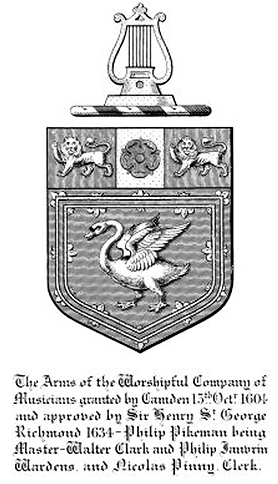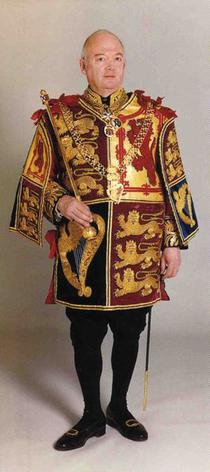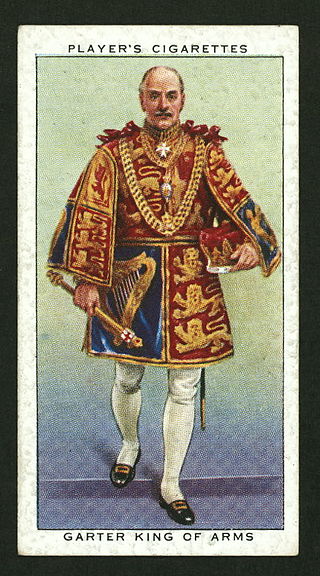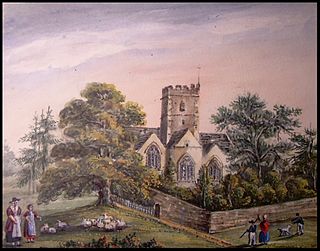Related Research Articles

The Worshipful Company of Musicians is one of the Livery Companies of the City of London. Its history dates back to at least 1350. Originally a specialist guild for musicians, its role became an anachronism in the 18th century, when the centre of music making in London moved from the city to the West End, and for more than a century it was a general guild for figures in the city, with no specific musical role. In the late 19th century, the musical element was revived, and the modern Company promotes all aspects of the art and science of music.

The College of Arms, or Heralds' College, is a royal corporation consisting of professional officers of arms, with jurisdiction over England, Wales, Northern Ireland and some Commonwealth realms. The heralds are appointed by the British Sovereign and are delegated authority to act on behalf of the Crown in all matters of heraldry, the granting of new coats of arms, genealogical research and the recording of pedigrees. The College is also the official body responsible for matters relating to the flying of flags on land, and it maintains the official registers of flags and other national symbols. Though a part of the Royal Household of the United Kingdom, the College is self-financed, unsupported by any public funds.

Walter Hungerford, 1st Baron Hungerford was an English knight and landowner, from 1400 to 1414 a Member of the House of Commons, of which he became Speaker, then was an Admiral and peer.

Norroy and Ulster King of Arms is the provincial King of Arms at the College of Arms with jurisdiction over England north of the Trent and Northern Ireland. The two offices of Norroy and Ulster were formerly separate. Norroy King of Arms is the older office, there being a reference as early as 1276 to a "King of Heralds beyond the Trent in the North". The name Norroy is derived from the Old French nort roy meaning 'north king'. The office of Ulster Principal King of Arms for All-Ireland was established in 1552 by King Edward VI to replace the older post of Ireland King of Arms, which had lapsed in 1487.

John Philip Brooke Brooke-Little was an English writer on heraldic subjects, and a long-serving herald at the College of Arms in London. In 1947, while still a student, Brooke-Little founded the Society of Heraldic Antiquaries, now known as the Heraldry Society and recognised as one of the leading learned societies in its field. He served as the society's chairman for 50 years and then as its president from 1997 until his death in 2006.

Sir Gerald Woods Wollaston was a long-serving officer of arms at the College of Arms in London. Wollaston's family had a firm tradition at the College of Arms. Wollaston's great-grandfather was Sir William Woods, Garter Principal King of Arms from 1838 until his death in 1842. His grandfather was Sir Albert William Woods who held the same post from 1869 to 1904.
Charles Harold Athill, MVO, FSA (1853–1922) was a long-serving officer of arms at the College of Arms in London.

Heraldic visitations were tours of inspection undertaken by Kings of Arms throughout England, Wales and Ireland. Their purpose was to register and regulate the coats of arms of nobility, gentry and boroughs, and to record pedigrees. They took place from 1530 to 1688, and their records provide important source material for historians and genealogists.
Blanche Lyon Pursuivant of Arms in Ordinary was an English office of arms created during the reign of King Edward IV.
John Watson was an English lawyer, Notary Public and the first Commonwealth Register at the Court of Chivalry and officer of arms at the College of Arms in London. He served as commissary and treasurer to Major Legge and Colonel Washington in the Royalist Army during the English Civil War. During the Commonwealth, Watson became acting Bluemantle Pursuivant at the College of Arms he was later appointed as Bluemantle for life. This appointment was later rescinded when the Monarchy was restored. Watson acted in an official capacity at the funeral of the Earl of Essex.

Sir George Nayler, KH FRS was a long-serving officer of arms at the College of Arms in London.

Sir William Segar was a portrait painter and officer of arms to the court of Elizabeth I of England; he became Garter King of Arms under James I.

Sir Leonard Holliday was a founder of the East India Company, and a Lord Mayor of London.

Note : dates are given using the New Style calendar.
Sir Walter Beauchamp was an English lawyer who was Speaker of the House of Commons of England between March and May 1416.

Sir Andrew Halliday, KH was a Scottish physician, reformer, and writer.

Gwladys ferch Dafydd Gam was a Welsh noblewoman. She was the daughter of Dafydd ap Llewelyn ap Hywel, otherwise known as Dafydd Gam, who was killed at the Battle of Agincourt in 1415.
Sir Henry St George (1581–1644) was an English Officer of arms. He was the third son of the herald Sir Richard St George and his wife Elizabeth St John.

Athlone Pursuivant of Arms was a junior officer of arms in Ireland, founded 1552 during the reign of Edward VI, King of England and King of Ireland, and was named for the town of Athlone, which is partly in Co. Roscommon . The other heraldic offices of Ireland being Ireland King of Arms, 1392-1485, the Ulster King of Arms (Ulster) from 1552, the Dublin Herald (Leinster) and the Cork Herald (Munster). Accordingly, an officer was named for each of the four traditional provinces of Ireland. From 1943 the Ulster King of Arms was merged with the Norroy King of Arms as the Norroy and Ulster King of Arms with jurisdiction for Northern Ireland. Heraldic matters in the Republic of Ireland are now handled by the office of the Chief Herald of Ireland.
William Ryley was an officer of arms at the College of Arms in London.
References
- 1 2 Burke, J. (1836) Genealogical and Heraldic History of the Commoners of Great Britain and Ireland.
- 1 2 3 Holladay, A.N. (1983). The Holladay Family.
- 1 2 Nicolas, Sir Harris (1827). History of the Battle of Agincourt.
- 1 2 3 4 5 6 Rastall, Prof G.R. (1968). Secular Musicians in Late Medieval England (doctoral thesis).
- 1 2 3 Gwynn-Jones, P.L. (Bluemantle Pursuivant) (1975). Letter dated 1 July 1975, quoted in Holladay, Alvis. M. (1983) The Holladay Family.
- ↑ Nicolas, Sir Harris (1834) Proceedings and Ordinances of the Privy Council of England Volume 3.
- ↑ "Calendar of the Patent Rolls Preserved in the Public Record Office : Henry VI Volume III" (PDF). Sdrc.lib.uiowa.edu. Retrieved 23 July 2020.
- 1 2 3 Crewdson, R. (2000) Apollo's Swan and Lyre
- ↑ Simons, E.N. (1966). The Reign of Edward IV.
- ↑ Holladay, A.N. (1983). The Holladay Family, citing Henry Hollyday's article 'Early History of the Hollyday Family' in the Maryland Historical Magazine (1931).
- ↑ Shaw, Dr W.A. (1904). The Knights of England Vol 1.
- ↑ "Halliday Heraldry". Net46.net. Retrieved 23 July 2020.